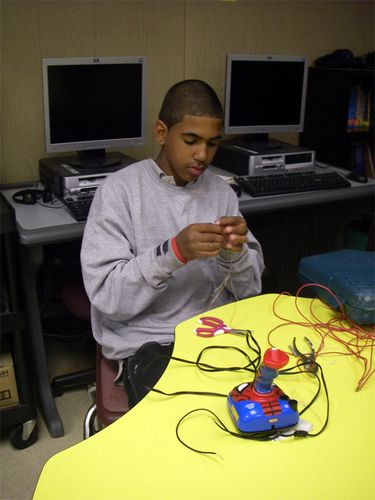Today is finally the day that I leave for Antarctica. It doesn't quite feel real. I went to school this morning and did some work on report cards. I also picked up S.A.R.A. Speaking of S.A.R.A...We ran into some difficulties. As you may remember, the students had decided to connect S.A.R.A. to a joystick because this would give the ROV more maneuverability. However, we had some problems. We discovered that the only way to connect the thrusters to a joystick was to use a relay. Actually, it turned out that we needed several relays. Unfortunately, time was not on our side. In order for S.A.R.A. to be able to go to Antarctica we needed to make some accommodations.
 Mr. Wagner, Dajonm, and Tyrone decide what we should do about the wiring.
Mr. Wagner, Dajonm, and Tyrone decide what we should do about the wiring.
Now, I don't want you to be discouraged because this is typical of real scientific research. Science is a learning process that can takes lots of turns and twists. However, it is this process of trial and error that makes science so exciting. Sometimes it is the mistakes that can make the difference. This is one time when being wrong can lead to something really good. S.C.I.N.I., the ROV I will be working with in Antarctica, has been developed as a result of trial and error (not to mention a lot of smarts on the part of Bob and the engineers).
The first decision we made was to get a fishing camera instead of trying to connect the small (one and a half inches long on each side) video camera that we already have. The benefits of using a fishing camera are that it is already waterproofed and has an infrared lighting system. It also has a small (five inches wide) television monitor and its own tether. The drawbacks are that the image is in black and white and there is no system for recording the data that S.A.R.A. collects. However, it is awfully cute. The camera is in the shape of a fish and it will be attached to the ROV using plastic ties.
Next, we decided it would take too long to connect S.A.R.A. to a joystick. This meant that we would need a control box with six switches (for up, down, forwards, backwards, left, and right) to operate S.A.R.A. You can't just go to the store and buy this type of control box. In fact, we searched on the internet and called over ten stores, including hobby shops and electronics distributors. We finally discovered that it would be necessary to build our own control box.
We bought a plastic project box that measures six inches by three inches by two inches and six toggle switches that are rated for 5 amps each. The next step was to drill six holes (one for each toggle switch). We also needed to drill a hole large enough for the wires from the thrusters and the tether.
 Garon is drilling holes in a plastic project box to make a control box with six toggle switches.
Garon is drilling holes in a plastic project box to make a control box with six toggle switches.
Mr. Wagner and Dajon (our class electronics expert) had connected each of the thrusters, the ground wire, and the tether using two contraptions that resemble plastic video game controllers that are shaped like guns. They actually are pretty cool looking.
 We are using two plastic cases that look like video game controllers to keep the wire connections waterproof.
We are using two plastic cases that look like video game controllers to keep the wire connections waterproof.
The next step is to connect the wires to the toggle switches in the control box. There was one slight problem. They completed making the project box this morning and I have to leave for the airport. The solution was to label the thrusters by the color of the wire that was attached to it. I was given very specific instructions about the steps I should use to connect the wires. Hopefully, when I get to Antarctica I will be able to finalize the wiring. Of course, if I have any problems, then I will be able to ask the experts. This means that S.A.R.A. will be a true collaboration between my students and the research team. Is that cool or what?
 Dajon is making the finally connections to get S.A.R.A. ready to travel to Antarctica. I will make the final connections when we get there.
Dajon is making the finally connections to get S.A.R.A. ready to travel to Antarctica. I will make the final connections when we get there.
Well, I'm running late (again). My flight leaves at 2:00pm and it is 12:15pm. I am getting ready to start an amazing adventure that I've dreamed of for many years. Dreams really can come true if you are willing to work for them. Thank you to PolarTREC, NSF, ARCUS, and Dr. Stacy Kim for helping to make my dream come true.

